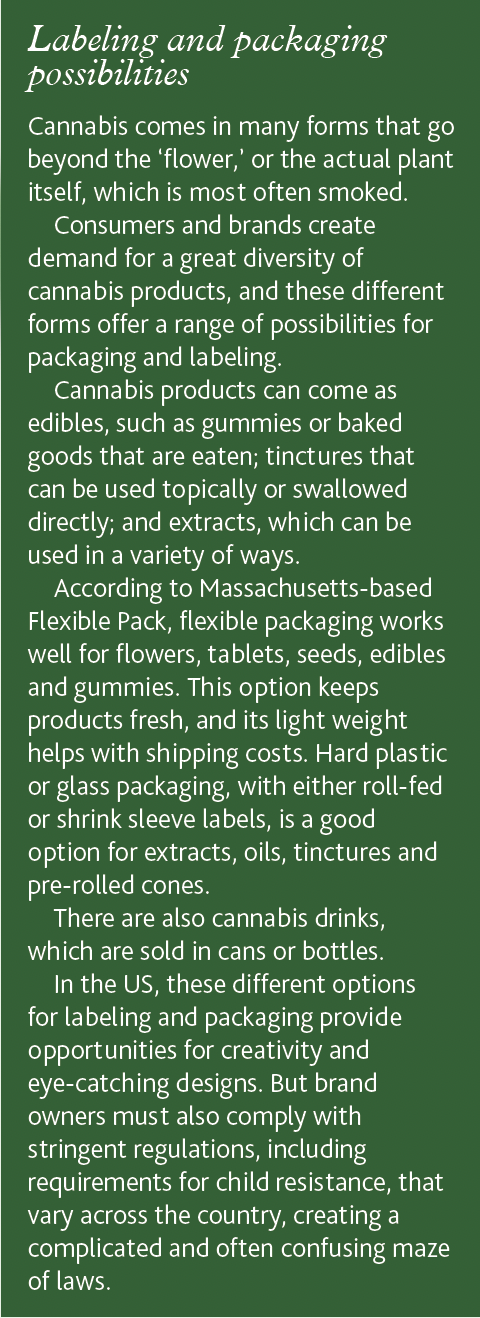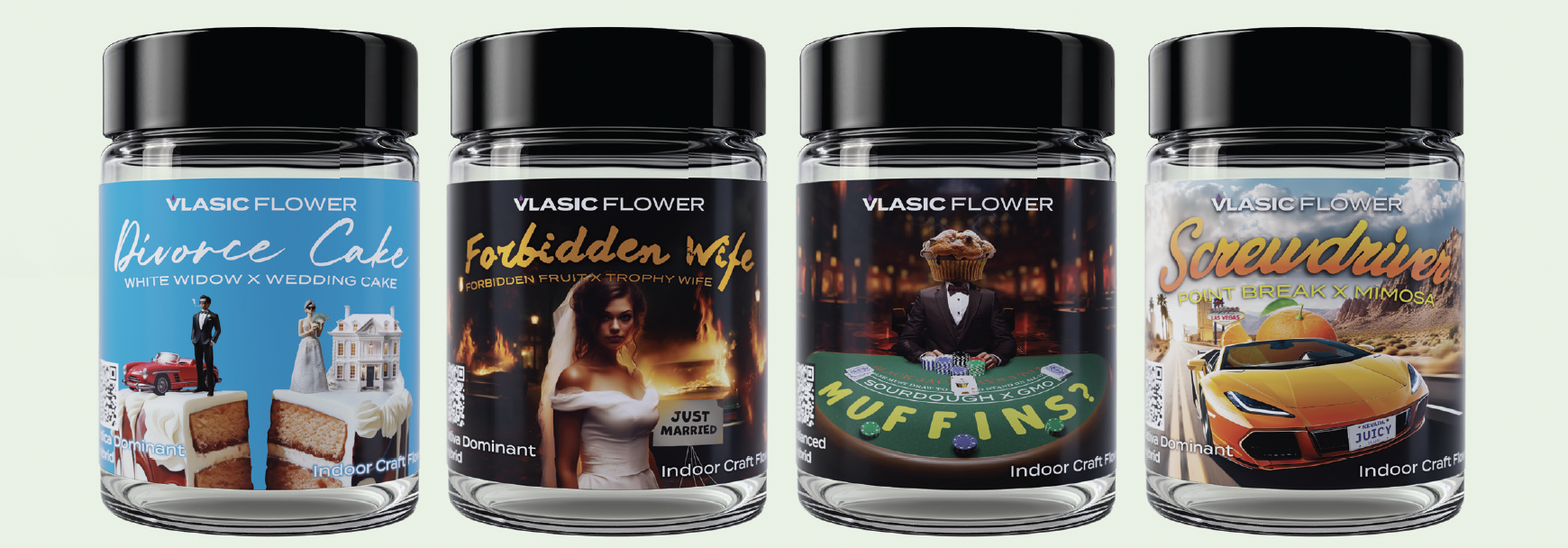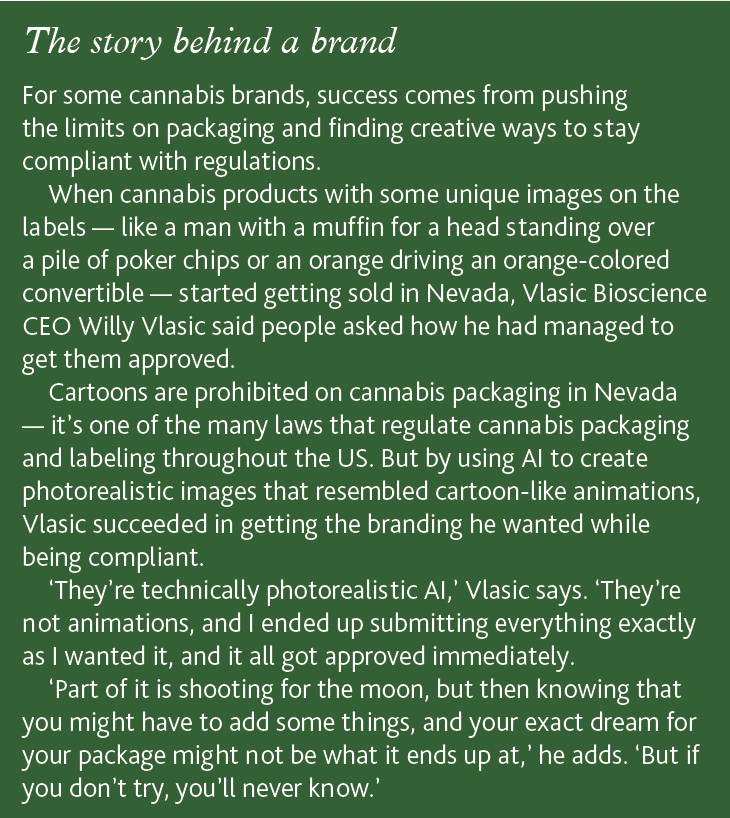Green new world
In the growing cannabis label and packaging market, label converters must balance design, regulatory compliance and pricing pressure.

As the cannabis industry continues its rapid expansion in the US, the importance of labels and packaging for this growing market is also in the spotlight.
According to Grand View Research, the US cannabis packaging market was valued at 1.4 billion USD in 2023 and is expected to grow at a staggering 28.9 percent CAGR through 2030 as more US states legalize cannabis for recreation and medical uses. The rising demand for cannabis in the US has been a boon for converters who see opportunities and new products emerge overnight.
But this so-called ‘green rush’ comes with its own set of unique challenges.
For converters and brand owners, navigating the complexities of this sector requires an understanding of the regulatory environment and balancing that with an eye for design and shelf appeal.
Regulatory environment
In the US, federal law prohibits cannabis use and sale, which means that the states with legal cannabis laws on the books are largely left to take the lead in crafting their own set of rules. Currently, recreational cannabis is legal in 24 states, plus Washington, DC, with medical cannabis, including low THC products, legal in an additional 23 states. This, in turn, creates a patchwork of regulations that can be dramatically different between neighboring states.
When it comes to cannabis packaging, state lawmakers have limits on a range of factors, such as a package’s opaqueness and thickness, the color and images, as well as rules designed to keep children from ingesting the product.
Because the regulations can vary from state to state, cannabis market experts have likened selling products in different states to going into business in 47 different countries.
Take Alaska, for example. There, cannabis packaging must be resealable. In California, the labeling must not include any likeness to candy. In Colorado, the required labeling text must be at least 1/16in in size. Some states, like New Mexico and Nevada, have requirements for using post-consumer recycled content in their packaging. Many states share certain requirements; many don’t.
Regulations can also change rapidly, meaning cannabis brands often need small quantities of ‘just in time’ labels and packaging, or they risk the laws changing, and their packaging becoming outdated and non-compliant.
Many US cannabis brands start by ordering their packaging from China, mostly for a perceived savings on cost. However, they may quickly realize the benefits of working with a domestic packaging supplier.
‘Being nimble is really important,’ says Willy Vlasic, CEO and co-founder of Vlasic Bioscience, a cannabis company in Michigan. ‘While you may be able to get packaging cheaper from China, you have to buy packaging in much larger quantities. It can be risky to get them in massive quantities depending on the state you’re working in because you don’t want to be stuck with packaging that becomes noncompliant.’
That nimbleness is one of the benefits Vlasic gets from working with Barbara Fox, founder and owner of Cannabiz Supply. Because Cannabiz Supply is a US company, Vlasic Bioscience can pivot quickly if and when the laws change.
Ultimately, packaging compliance is the responsibility of brands, says Fox. But by specializing in labeling for cannabis products, she can provide a level of expertise that’s helpful to brands, especially in such a young and dynamic industry.
Fox has an interesting foray into the cannabis space. She was a medical student in Nevada when her father called her with an interesting proposition. He was working with a cannabis cultivator and said, ‘You’re creative, can you help us with the packaging?’

From there, Fox eyed the opportunity in this new frontier. She soon moved from helping with packaging designs to helming Cannabiz Supply, today a 6M USD business in Las Vegas, Nevada. All this before Fox turns 30.
Fox offered advice to those entering the cannabis market during a conference session at Labelexpo Americas 2024, where she discussed the challenges of understanding the ever-changing regulations.
‘The same product that a cannabis brand brings to market in Ohio is treated differently in Illinois, even though these states are so close to each other,’ she explains. ‘This is where having to be an expert in compliance, in packaging, in materials is extremely important. We often need to educate cannabis cultivators and processors on the latest packaging regulations.’
While the rules vary from state to state, there’s one nearly universal packaging regulation: child safety.
Child safety regulations are designed to help protect children from accidentally ingesting cannabis products, which means brands are required to make sure children are unable to get into the product. On flexible packaging, this can be done with specialty zippers or thick 4mil films. The idea is to keep children out while still being accessible to adult consumers.
Child-resistant packaging is increasingly important as the products expand beyond the flower, or cannabis plant, to include topicals, concentrates, edibles and more. Lawmakers tend to focus child safety legislation on edibles since children may confuse them for candy.

Shelf appeal
Much like wine and spirits verticals, research shows that over one-third of consumer purchase choices are based on packaging alone. Cannabis packaging is no stranger to this. However, there are rules to the images printed on the packaging.

Customers in cannabis dispensaries looking to purchase products can’t touch the packaging until they leave the store and are often required to have the products in a separate sealed bag when they exit the store. That means that tactile effects, like embellishments, may not be as impactful, but visually appealing features, such as metallics and holographics, can help a product stand out.
‘The only way for these brands to be able to shine is to see how pretty is it,’ Fox says. ‘And that’s why you’ll see quite a bit of labels and packaging with holographic and metallics. It’s because it needs to shine.’
Ed Wiegand is CEO of JetFx, a digital embellishment print bar that’s the choice of some cannabis label packaging manufacturers for its ability to achieve digital spot coating, screen, foils, cast and cure, holograms and more.
Wiegand says: ‘The beauty of the JetFX digital embellishment system is that printers or brands can innovate their graphic designs with almost endless combinations of the embellishments to achieve special packaging not easily accomplished with analog embellishments.
‘I believe the opportunity for US printers in the cannabis space is in unique capability printing. Digital embellishments can differentiate the packaging for brands. China will have difficulty meeting these aesthetics,’ he says.
A different future?
For now, the legal landscape in the US is challenging to navigate. But that could change in the future.
Currently, cannabis on the federal level in the US is classified as a Schedule I drug, defined as having no known potential medical use and a high risk of abuse, putting it in the same class as heroin and LSD.
However, cannabis market watchdogs in the US are waiting to see whether the Drug Enforcement Administration will reclassify cannabis from Schedule I to a lesser Schedule III drug. A Schedule III designation would put cannabis into the same category as drugs such as acetaminophen with codeine and anabolic steroids, enabling more universal standards for the cannabis market – including its packaging. This change could bring a flood of businesses and opportunities into the market.
‘If the DEA (changes the cannabis designation), then we’re going to see a lot of universal standards and packaging compliance being implemented,’ says label converter Fox. ‘That’s what I hope. It will allow for a lot of big businesses and more private equity investors to enter the market. They’ve traditionally been afraid to touch cannabis.’
A green rush?
Because cannabis is a federally prohibited drug, banking in the cannabis industry is one of the more complex challenges, as these brands don’t have access to traditional banking services, like checking accounts, credit cards or business loans. Many US brands are hesitant to work with cannabis businesses until cannabis reforms are passed at the federal level.
The result is a cannabis market that’s largely a cash-based business, a challenge that stifles the wider market growth.
‘The way the cannabis industry is right now, it’s not a gold rush of money. These brands have extremely strict budgets,’ Fox says. ‘When you have a very strict budget like the cannabis industry does, the packaging needs to be low-cost. We need to balance that value with top-shelf appeal.’
Further, Fox adds cannabis brands are seen as professional, legitimate businesses.
‘They have very professional artwork, established corporate marketing teams behind them,’ she says. ‘But there are still some mom-and-pop brands where they really expect us as converters and operators to guide them in decision-making of what their packaging ends up looking like.
‘They’re not experts with print backgrounds. We have to educate them on what embossing is, what UV printing is, and what’s possible with their packaging. They don’t know what they don’t know.’


Stay up to date
Subscribe to the free Label News newsletter and receive the latest content every week. We'll never share your email address.




